NOTE: Bloomberg Second Measure launched a new and exclusive transaction dataset in July 2022. Our data continues to be broadly representative of U.S. consumers. As a result of this panel change, however, we recommend using only the latest posts in assessing metrics, and do not support referring to historical blog posts to infer period-over-period comparisons.
Blue Apron can’t catch a break. It just announced layoffs after going public in June and being dubbed one of the worst IPOs of the year. But it’s not all bad news in the meal kit industry. Grocery giant Albertsons acquired Plated in September, and this month German company HelloFresh announced plans to IPO. Never to be outdone, Amazon is also testing a new meal-kit service in Seattle.
Despite growing pains for some companies, a surge of new players have entered the market—all promising to bring the healthiest, freshest, tastiest ingredients (in the best-chilled cardboard boxes) right to your doorstep. So which one is “the best?” We looked at nine companies that claim at least 1 percent of U.S. market share to find out.
Largest U.S. Market Share: Blue Apron
The blue ribbon for market share goes to Blue Apron. Among the companies analyzed, Blue Apron is the largest service, claiming 40 percent of U.S. meal kit sales. It enjoys a shrinking lead over its closest competitors, HelloFresh (28 percent) and Home Chef (10 percent).
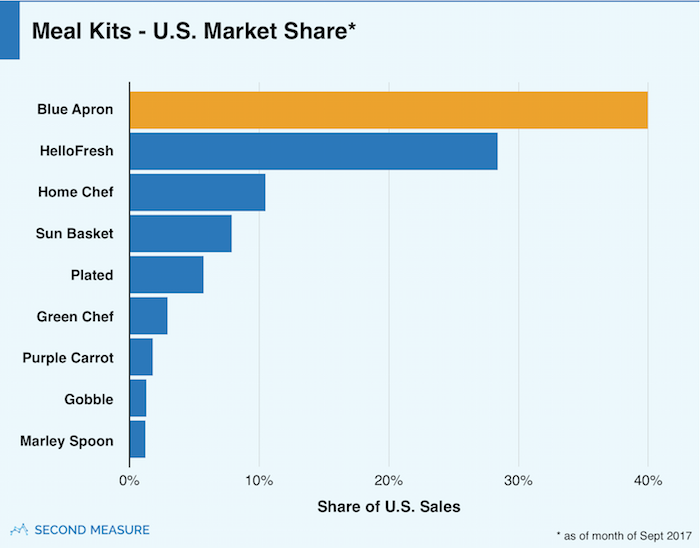
This might be a bittersweet victory for Blue Apron after challenges at a new fulfillment center added to its struggles this summer. Subsequent plans to scale back marketing mean that, not too long from now, it could be anyone’s race.
Highest Rate of Growth: Purple Carrot
Meal kits have historically seen the best quarterly growth during Q1. It’s not entirely clear why customers tend to enter the market at the beginning of the year, although New Year’s resolutions and redeemed holiday gifts are likely factors. So while a slowdown in growth is expected throughout the year, 2017 has been particularly tough for meal kits, and the industry actually contracted during Q3.
But some players are managing to maintain growth. Sun Basket gets honorable mention for most-improved quarter, showing Q1 quarterly sales growth of 80 percent. But Purple Carrot’s standout performance in a tough quarter makes it the winner in this category, with Q3 quarter-over-quarter growth of 48 percent.
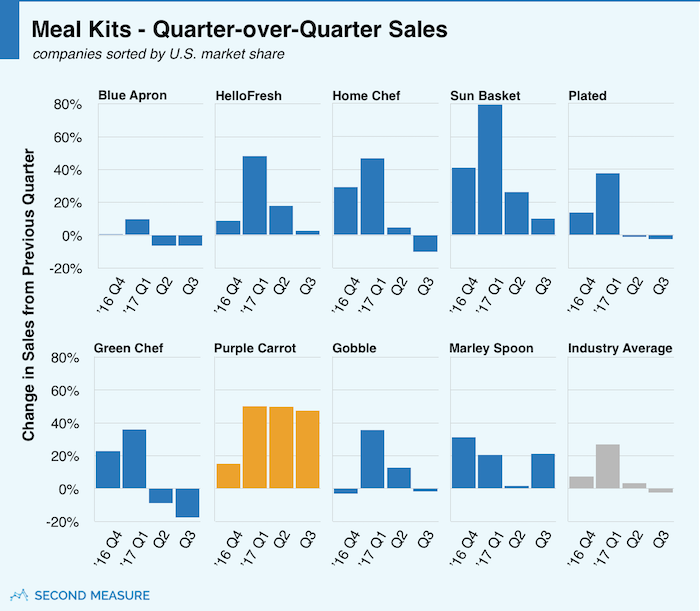
Purple Carrot also led in customer growth, with Q3 quarter-over-quarter growth of 54 percent. Its “plant-based” (vegan) menu seems to be successfully reaching a distinct segment of the market with help from a partnership with Whole Foods. Starting in October 2016, Whole Foods sold a limited range of Purple Carrot kits in select stores as a way to attract new customers to the full range of online offerings. Over the past year, Purple Carrot tripled its customer count. But with Whole Foods’ new parent, Amazon, entering the meal-kit market, Purple Carrot may need to look elsewhere to drive future growth.
Most Self-Confidence in Potential Growth: HelloFresh
HelloFresh, one of the companies that managed to see growth in Q3, recently shared its positive outlook on upcoming business by claiming it’s on track to overtake Blue Apron. Sales data shows that the lead-change might not be far off. Average quarterly growth rates from the past year suggest HelloFresh could surpass Blue Apron in sales during Q2 of next year. But if Blue Apron sales continue to decline as fast as they did in Q3, it could happen even sooner.
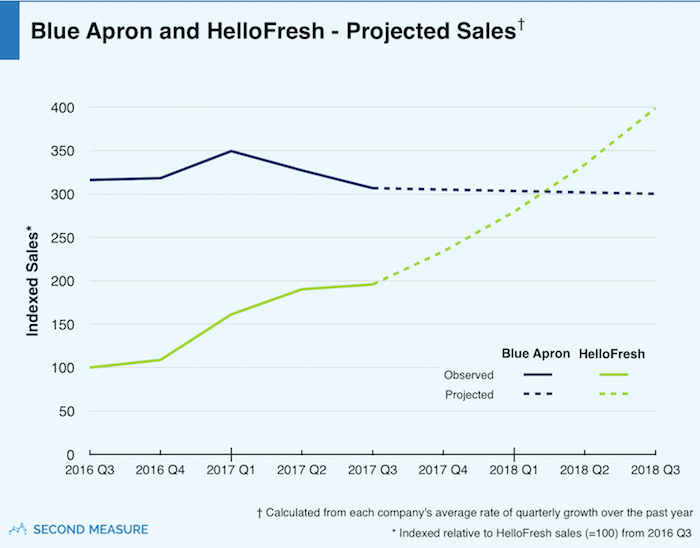
Best Customer Retention: Gobble
This month, Gobble announced it raised $15 million in its Series B financing. Looking at customer retention data, it’s clear why investors would be interested. After one year, Gobble was best at hanging on to new customers; it retained an average of 19 percent of its customers from 12 months prior. Runner-up Sun Basket also performed well with an 18 percent retention rate.
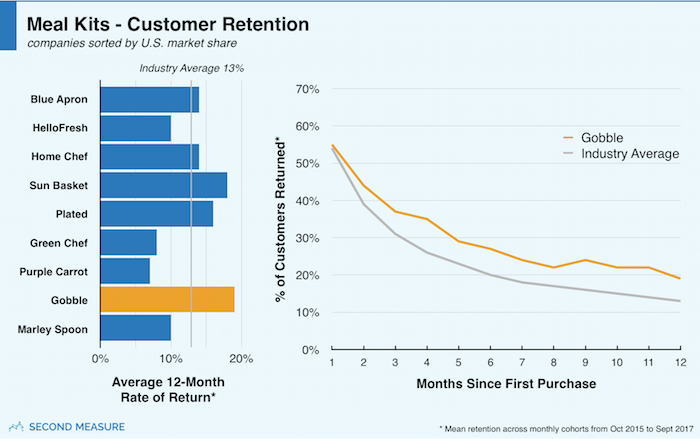
Sun Basket’s second place finish across multiple categories is noteworthy, especially considering that the winner for overall growth, Purple Carrot, finishes last in retention—just 7 percent of its customers return after one year.
Highest Customer Spending: Gobble
More impressively, Gobble outshines the competition when it comes to monetizing customers. Consumer data from the past two years shows Gobble customers spent an average of $897 in a year. Sun Basket again came in second, with its customers averaging $843 in their first year.
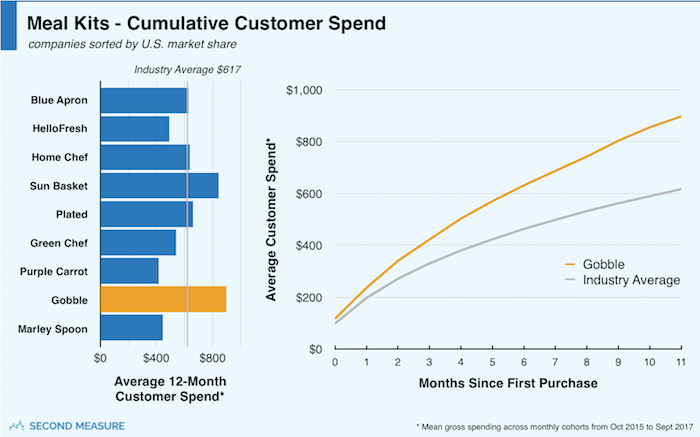
It’s worth noting that Gobble portions typically run $2 (17-20 percent) more than comparable offerings from other strong performers like Plated and Sun Basket. But even after attributing some of its dominance to a higher purchase point, it’s clear Gobble has an enthusiastic following.
Winning out in two observed categories, you might be wondering: what’s so special about Gobble? While some competitors have attempted to carve out a niche by catering to food preferences (like organic or paleo menu items), Gobble’s pitch addresses a different customer concern: time. With the promise of 15-minute meals cooked in one pan, Gobble aims to be a sustainable dinner option for busy customers. Other competitors’ kits can require labor-intensive preparations and create more of a gourmet date-night experience.
Request a demo today to observe past and future customer trends from the meal-kit industry.
